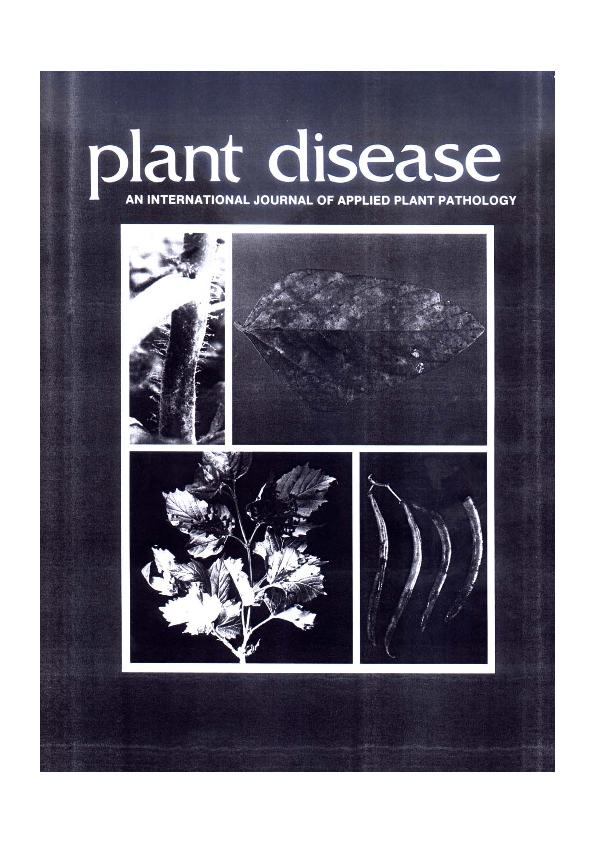Mostrar el registro sencillo del ítem
dc.contributor.author
Ploper, Leonardo Daniel

dc.contributor.author
Gonzalez, V.
dc.contributor.author
Galvez, M. R.
dc.contributor.author
de Ramallo, N. V.
dc.contributor.author
Zamorano, M. A.
dc.contributor.author
Garcia, M. G.
dc.contributor.author
Castagnaro, Atilio Pedro

dc.date.available
2019-12-09T19:35:49Z
dc.date.issued
2005-12
dc.identifier.citation
Ploper, Leonardo Daniel; Gonzalez, V.; Galvez, M. R.; de Ramallo, N. V.; Zamorano, M. A.; et al.; Detection of soybean rust caused by Phakopsora pachyrhizi in northwestern Argentina.; American Phytopathological Society; Plant Disease; 89; 7; 12-2005; 774-774
dc.identifier.issn
0191-2917
dc.identifier.uri
http://hdl.handle.net/11336/91768
dc.description.abstract
Asian soybean rust, caused by Phakopsora pachyrhizi, is regarded as one of the most destructive diseases of soybean [Glycine max (L.) Merr.]. In Argentina, it was first detected in the province of Misiones in northeastern Argentina near Paraguay and Brazil during the 2001-02 growing season. The following season it also was found in the neighboring province of Corrientes. However, it did not reach major soybean production areas in northern Argentina until the end of the 2003-04 season. In April 2004, as soybean crops were nearing maturity, the disease was found throughout the region of northwestern Argentina, which includes the provinces of Tucumán, Salta, Jujuy, Catamarca, and Santiago del Estero, where approximately 6% of the soybean crop of Argentina is produced. During February and March the area had a severe drought and above average temperatures, but in April rainfall was abundant, particularly during the first half of the month. Soybean rust was first observed on 16 April in several locations of the departments (counties) of Moreno and Jimenez in the province of Santiago del Estero, and the following week in the departments of Alberdi, Burruyacu, Cruz Alta, Famaillá, La Cocha, and Leales in the province of Tucumán; in the department of Santa Rosa in the province of Catamarca; and in the departments of Anta, Metán, Rosario de la Frontera, and San Martín in the province of Salta. In those fields where the disease was detected, nearly all plants showed symptoms. Affected crops were mostly in growth stages R7 to R8, except for a few fields that had been planted late and were in a late R5 stage. Yield losses of up to 28% and premature defoliation occurred in these fields only. Disease severity, measured as percentage affected leaf area, ranged from 45 to 50% in untreated fields and from 0.9 to 39% in fungicide-treated fields. Leaf lesions were reddish-brown, irregularly shaped, and were more abundant on the abaxial surface. Under the dissecting microscope, uredinia were observed as erumpent pustules with a conspicuous central pore. Masses of urediniospores were expelled through the pore and covered the pustules. Urediniospores were hyaline to pale yellow-brown, sub globose to ovoid, with finely echinulate, hyaline walls and an average size of 27.8 x 18.5 ¦Ì. Because there are two morphologically similar species of Phakopsora that infect soybean, P. pachyrhizi (the Asian species) and P. meibomiae (the New World species), a molecular differentiation was carried out using the PCR assay described by Frederick et al. DNA extracted from 37 samples from different locations was amplified using specific primers for both species of Phakopsora and specific primers for P. pachyrhizi and for P. meibomiae. Twenty-eight samples amplified with the two-species primers and with the P. pachyrhizi primer. None of the samples amplified with the P. meibomiae primer. Specimens have been deposited at Instituto Miguel Lillo, Tucumán, Argentina. These results confirmed the presence of P. pachyrhizi in the provinces of Catamarca, Tucumán, Salta, and Santiago del Estero, Argentina
dc.format
application/pdf
dc.language.iso
eng
dc.publisher
American Phytopathological Society

dc.rights
info:eu-repo/semantics/openAccess
dc.rights.uri
https://creativecommons.org/licenses/by-nc-sa/2.5/ar/
dc.subject
Asia soybean
dc.subject
northwestern Argentina
dc.subject
Phakopsora pachyrhizi
dc.subject.classification
Otras Ingenierías y Tecnologías

dc.subject.classification
Otras Ingenierías y Tecnologías

dc.subject.classification
INGENIERÍAS Y TECNOLOGÍAS

dc.title
Detection of soybean rust caused by Phakopsora pachyrhizi in northwestern Argentina.
dc.type
info:eu-repo/semantics/article
dc.type
info:ar-repo/semantics/artículo
dc.type
info:eu-repo/semantics/publishedVersion
dc.date.updated
2019-11-25T19:10:31Z
dc.journal.volume
89
dc.journal.number
7
dc.journal.pagination
774-774
dc.journal.pais
Estados Unidos

dc.journal.ciudad
St. Paul
dc.description.fil
Fil: Ploper, Leonardo Daniel. Consejo Nacional de Investigaciones Científicas y Técnicas. Centro Científico Tecnológico Conicet - Tucumán. Instituto de Tecnología Agroindustrial del Noroeste Argentino. Provincia de Tucumán. Ministerio de Desarrollo Productivo. Estación Experimental Agroindustrial "Obispo Colombres" (p). Instituto de Tecnología Agroindustrial del Noroeste Argentino; Argentina
dc.description.fil
Fil: Gonzalez, V.. Consejo Nacional de Investigaciones Científicas y Técnicas. Centro Científico Tecnológico Conicet - Tucumán. Instituto de Tecnología Agroindustrial del Noroeste Argentino. Provincia de Tucumán. Ministerio de Desarrollo Productivo. Estación Experimental Agroindustrial "Obispo Colombres" (p). Instituto de Tecnología Agroindustrial del Noroeste Argentino; Argentina
dc.description.fil
Fil: Galvez, M. R.. Consejo Nacional de Investigaciones Científicas y Técnicas. Centro Científico Tecnológico Conicet - Tucumán. Instituto de Tecnología Agroindustrial del Noroeste Argentino. Provincia de Tucumán. Ministerio de Desarrollo Productivo. Estación Experimental Agroindustrial "Obispo Colombres" (p). Instituto de Tecnología Agroindustrial del Noroeste Argentino; Argentina
dc.description.fil
Fil: de Ramallo, N. V.. Consejo Nacional de Investigaciones Científicas y Técnicas. Centro Científico Tecnológico Conicet - Tucumán. Instituto de Tecnología Agroindustrial del Noroeste Argentino. Provincia de Tucumán. Ministerio de Desarrollo Productivo. Estación Experimental Agroindustrial "Obispo Colombres" (p). Instituto de Tecnología Agroindustrial del Noroeste Argentino; Argentina
dc.description.fil
Fil: Zamorano, M. A.. Consejo Nacional de Investigaciones Científicas y Técnicas. Centro Científico Tecnológico Conicet - Tucumán. Instituto de Tecnología Agroindustrial del Noroeste Argentino. Provincia de Tucumán. Ministerio de Desarrollo Productivo. Estación Experimental Agroindustrial "Obispo Colombres" (p). Instituto de Tecnología Agroindustrial del Noroeste Argentino; Argentina
dc.description.fil
Fil: Garcia, M. G.. Consejo Nacional de Investigaciones Científicas y Técnicas. Centro Científico Tecnológico Conicet - Tucumán. Instituto de Tecnología Agroindustrial del Noroeste Argentino. Provincia de Tucumán. Ministerio de Desarrollo Productivo. Estación Experimental Agroindustrial "Obispo Colombres" (p). Instituto de Tecnología Agroindustrial del Noroeste Argentino; Argentina
dc.description.fil
Fil: Castagnaro, Atilio Pedro. Consejo Nacional de Investigaciones Científicas y Técnicas. Centro Científico Tecnológico Conicet - Tucumán. Instituto de Tecnología Agroindustrial del Noroeste Argentino. Provincia de Tucumán. Ministerio de Desarrollo Productivo. Estación Experimental Agroindustrial "Obispo Colombres" (p). Instituto de Tecnología Agroindustrial del Noroeste Argentino; Argentina
dc.journal.title
Plant Disease

dc.relation.alternativeid
info:eu-repo/semantics/altIdentifier/doi/https://doi.org/10.1094/PD-89-0774B
dc.relation.alternativeid
info:eu-repo/semantics/altIdentifier/url/https://apsjournals.apsnet.org/doi/10.1094/PD-89-0774B
Archivos asociados
